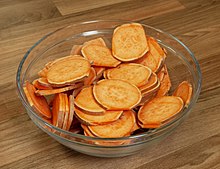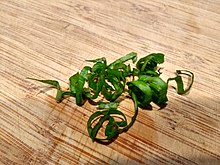Cookbook:Knife Skills
Cookbook | Recipes | Ingredients | Equipment | Techniques | Cookbook Disambiguation Pages | Cooking techniques
Cutting is one of the most basic kitchen preparation skills. By far the most common utensil for this is a chef's knife, although a paring knife and others are also used. With practice, cutting food can be safe, fun, and easy, and it is a skill that is well worth developing for anyone who prepares food.
Use
[edit | edit source]
Knife grip
[edit | edit source]When slicing food by hand, always grip the handle of the knife firmly—a loose grip can lead to accidents. The correct grip provides the maximum degree of control over the knife. It increases one's accuracy and speed, as well as preventing slipping which can cause accidents. The type of grip one uses depends to some extent on the task being performed, as well as the size of the knife. The grip most frequently used for general cutting and slicing is the one illustrated. Grasp the handle in the palm of the hand with the thumb on one side of the blade, the forefinger on the other side, and the middle, ring and small fingers wrapped around the handle. This is commonly referred to as a "pinch grip" and is believed by many food-service professionals to give maximum control. Those without culinary training often grip the handle with all four fingers and the thumb gathered underneath.
Food grip
[edit | edit source]The food item is held firmly with the other hand, with the fingers curled under so that the side of the blade is against the knuckles. The curling under of the hand holding the food is extremely important and is a safety requirement that must never be disregarded even when the knife is nowhere near one's fingers so as to make it an automatic habit. Many accidents, and indeed the loss of digits, could have been avoided if this technique were always followed. Regrettably, even professionals sometimes disregard their own rules—resist the temptation to do so.
Other
[edit | edit source]- When using a mandoline, use the food holder which is supplied with it. If it didn't have one when you bought it, it is quite likely being illegally sold in your jurisdiction which probably requires that they be sold with a holder included.
- When passing a knife to another person, do so handle first.
Techniques
[edit | edit source]Boning
[edit | edit source]In the culinary language, to bone means to remove all bones from inside an item.
Slicing
[edit | edit source]
Slicing is the cutting of food into thin, relatively broad slices. Slices may be used as they are or processed further to produce other speciality cuts such as chiffonade, rondelles, diagonals, oblique or roll cuts, and lozenges. Slicing may be accomplished by hand or machine. Mechanized slicers include rotary slicers and food processors with a slicing attachment. A mandoline greatly increases both the speed and uniformity of slices produced and are available for both professional and home use.
One of two methods may be used for slicing:
- Method A: The tip of the knife rests on the cutting board while the food item is held with the other hand. The knife is rocked up and down. On the downward movement, the blade moves down and forward to slice through the item, keeping the tip on the cutting board. If the item is too large to rest the tip on the work surface, the same motion is used but the tip points toward the cutting board while one pushes the knife down and forward through the food in one movement. Do not saw backwards and forwards.
- Method B: Gripping the item with one's fingers curled under as described, use the wrist as a fulcrum and the second joint of one's index finger as a guide. With the heel of the knife on the cutting board, the tip is lifted and one slices by drawing the knife slightly back toward you and down through the item, using the knuckle of the index finger to adjust the thickness of each cut. The motion of the knife should be almost entirely from the wrist, not from the elbow.
Chiffonade
[edit | edit source]
Chiffonade is a technique in which herbs or leafy green vegetables (such as spinach and basil) are cut into long, thin strips. The term comes from the French language and means "made of rags" referring to the fabric-like strips that result in this technique. It is generally accomplished by stacking leaves, rolling them tightly, then cutting across the rolled leaves with a sharp knife, producing fine ribbons. To chiffonade, place a large stack of basil leaves in your fingertips, largest leaves at the bottom. Roll tightly and place down on a cutting board and cut thinly across, while keeping your knife tip in contact with the board at all times.
Julienning
[edit | edit source]
To julienne a vegetable or other ingredient is to cut it into long thin matchstick-sized strips 1/16–⅛ inch (1.5–3 mm) wide and 2–3 inches (5–7 cm) long. A baton is larger, at almost ¼ inch wide, and is also the starting point for the small dice.
Trimming the ends of the vegetable and the edges to make four straight sides makes it easier to produce a uniform cut; trimmings can be used for stocks, soups, purees, etc. To julienne a carrot, first cut it into cylindrical sections of the desired length. Trim each section so that the sides are straight and right-angled (almost like a cuboid). Slice into flat panels of desired width. Stack these panels and slice evenly into matchsticks.
Chopping
[edit | edit source]Chopping is used to break food down into smaller pieces with no defined shape. It may be coarse or fine, in which case it should be specified in the recipe (e.g. coarsely-chopped, etc). To chop parsley, for example, grip the handle of a chef's knife. Pinch the part of the blade closest to the handle. With your other hand, if you are chopping something like a chiffonade, hold the target food steady. If doing something like nuts, place your palm in the middle of the blunt end. Rock the knife up and down rapidly, keeping the tip on the work surface, and gradually move the blade sideways over the food item on the chopping board. In order to ensure that all of the product is properly chopped, rearrange the pile from time to time if you are doing nuts or vegetables and continue until you have reached the desired degree of fineness.
Mincing
[edit | edit source]Mincing is a technique for rendering food into very small pieces, but not as far as a purée. Mincing is for a variety of purposes, such as making minced meat (also just mince, ground beef, etc.), fruit mince, or minced garlic. Mincing can be achieved using a meat grinder or mincer, a food processor, a grater, or a knife and chopping board.

Cubing/Dicing
[edit | edit source]Cubing refers to cutting an ingredient into cubes, and to dice means to cut into small cubes. The size is often specified in the recipe, and in classical French cooking there are four sizes:
- Brunoise: ⅛ x ⅛ x ⅛ inch (3x3x3 mm) cubes
- Small dice: ¼ x ¼ x ¼ inch (6x6x6 mm) cubes
- Medium dice: ⅜ x ⅜ x ⅜ inch (9x9x9 mm) cubes
- Large dice: ⅝ x ⅝ x ⅝ inch (1.5 x 1.5 x 1.5 cm) cubes
Other ways of cutting in to small pieces, but not cubes, include:
- Paysanne: not a cube but within the same category as dice. The dimensions are ½ x ½ x ¼ inches (12 x 12 x 6 mm)
External Links
[edit | edit source]- "Basic Knife Technique." Cook’s Illustrated, January/February 1996.
- "Basic Knife Techniques." Cooking Enthusiast, 2006.
- Marsha Lynch: Basic Knife Skills
- British Nutrition Foundation videos on basic peel, chop and grate techniques